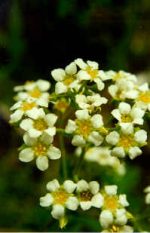 Large boykinia is a herbaceous perennial and a member of the saxifrage family, Saxifragaceae, that also includes astilbe, foamflower, and coral bells. It is native to Oregon, Idaho, California, and Montana where it grows in moist meadows and riparian sites. Growing from a rhizomateous rootstock, plants are 1.6-3.3′ tall and have brown hairy stems covered with glands and leaves that up to 20″ long and carried on petioles up to 14″ long. Each palmate leaf is deeply divided into 3 to 7 lobes with sharply toothed margins. In summer panicles of small white flowers appear on thin stems up to 36″ long. Each flower is up to 1/4″ across and has five round to oval petals, five pointed sepals, and a yellowish center. The genus name, Boykinia, honors the American field botanist, Dr. Samuel Boykin (1786-1846). Suitable for ground cover. The specific epithet, major, is the Latin word meaning larger.
Large boykinia is a herbaceous perennial and a member of the saxifrage family, Saxifragaceae, that also includes astilbe, foamflower, and coral bells. It is native to Oregon, Idaho, California, and Montana where it grows in moist meadows and riparian sites. Growing from a rhizomateous rootstock, plants are 1.6-3.3′ tall and have brown hairy stems covered with glands and leaves that up to 20″ long and carried on petioles up to 14″ long. Each palmate leaf is deeply divided into 3 to 7 lobes with sharply toothed margins. In summer panicles of small white flowers appear on thin stems up to 36″ long. Each flower is up to 1/4″ across and has five round to oval petals, five pointed sepals, and a yellowish center. The genus name, Boykinia, honors the American field botanist, Dr. Samuel Boykin (1786-1846). Suitable for ground cover. The specific epithet, major, is the Latin word meaning larger.
Type: Herbaceous perennial
Bloom:Small white flowers in panicles in summer
Size: 1.6-3.3′ H
Light: Full sun to partial shade
Soil: Average, consistently moist, well-drained
Hardiness: Zones 5-7
Care: Low Maintenance
Pests and Diseases: None of significance
Propagation: Seed, division
Companion Plants: Blazing star, cardinal flower, knotweed, astilbe
Alberta, south to Idaho; Oregon and California
saxifrage family known by the common name large boykinia. It is native to the western United States from California to Montana, where it grows in shady forest understory and wet mountain meadows. It is a rhizomatous perennial herb producing large leaves with blades up to 50 centimeters long, borne on petioles up to 35 centimeters in length. Each leaf has several lobes which are often sharply toothed along the edges. The inflorescence reaches up to a meter tall on a thin stem. It bears a dense, flat-topped array of many small white flowers with yellowish centers, each with five pointed sepals and five larger rounded or oval petals.
HT 1.6-3.3′; moist meadows; sun, part shade
Stems brown-hairy and glandular pubescent, ascending to erect, 20–90 cm from a nearly horizontal rootstock. Leaves petiolate, leafy-stipulate; the blade reniform, cordate, deeply 3- to 7-lobed with dentate margins, 2–20 cm wide, sparsely hairy, glandular-hairy on the veins beneath. Inflorescence a glandular, many-flowered, hemispheric panicle. Flowers campanulate, epigynous; calyx 3–5 mm long with a short tube and lanceolate lobes 1–4 mm long; petals 5–8 mm long, white, clawed; the blade ovate; stamens 5, inserted at the top of hypanthium. Capsules 4–5 mm long at maturity
It lays down a mat of strongly lobed, serrated leaves close to the ground from which rise the stalks with umbels of white flowers.
Erect, stout stem coated with glands. Leaves with petioles 2–12 in. tall, with conspicuous, toothed, leaf-like stipules. Leaf blades to 8 in. across, lobed halfway to base, lobes with straight sides, entire or toothed. Flower head dense, more or less flat-topped. Flower petals white, about 1/5–1/4 in. across, broadly oval to round. Grows in shaded areas, moist meadows, banks.
- Rarity: Locally Common
- Flowering Time: All Summer
- Life Cycle: Perennial
- Height: 12–36 inches
- Habitat: Meadow, Moist Riverbanks
- tall leafy stem growing from short rhizomes. Lower leaves are heart to kidney shaped with several lobes and often sharply toothed along the edges. Leaves at the base of the plant can be up to 8 in (20cm) across. It bears a dense, flat-topped array of many small white flowers with yellowish centers reaching up to 3 ft (1m) tall and blooms from early summer to early fall.Ecology: common species of moist shady forests and riparian locations, Boykinia major is found near wet meadows, pond and lake margins, from sea level to 7500 ft (2286 m).Growing Conditions: partial to full shade, evenly moist soil
- Habit: Plant (2)5–1.3 dm, stout. Leaf: 9–50 cm; stipules conspicuous, +- 1 cm or more, green, entire or teeth generally sharp-tipped, distal leaf-like; petiole 5–35 cm; blade < 20 cm wide, divided > 1/2 to base, lobes and teeth +- straight-sided. Inflorescence: +- flat-topped; branches occasionally coiled at tip; flowers crowded. Flower: calyx lobes 2–5 mm, triangular to elliptic; petals 5–7 mm, elliptic to round. Palmate leaves
Ecology: Shaded, moist meadows, streambanks; Elevation:
Zones 5-9 (DG) 7 probably more tealistic and seen on some site